
The Island in the Middle of Everywhere exhibition invites you on a remarkable journey to Xwe’etay (pronounced hwe-e-tay), also known as Lasqueti Island, which is part of the Northern Gulf Islands in British Columbia.
The Xwe’etay/Lasqueti Archaeological Project (XLAP) brings together Coast Salish peoples and settler residents to honour the age-old Indigenous presence on Lasqueti Island. The island is the traditional home of Northern Coast Salish peoples.
Through a series of stunning photographs and a video, The Island in the Middle of Everywhere showcases the archaeological work in progress and the beauty of the island itself. The exhibition was co-curated by the XLAP and the Canada Agriculture and Food Museum, and reflects the museum’s ongoing commitment to its Indigenous Foodways research initiative.
Before Europeans arrived, the Northern Coast Salish skillfully managed the land and sea of Xwe’etay to create a rich and secure supply of fish, clams, plants, and other foods. Along the shore, below the high-tide line, people built terraces to increase clam numbers and productivity. Fish traps captured salmon and herring. In grassy areas, Indigenous cultivators raised beds of the beautiful purple camas lily, harvested for its starchy bulb.
These practices created a landscape of food that fed generations of Xwe’etay residents. Today, the XLAP archaeological team is uncovering how Indigenous people sustainably produced food over thousands of years. The remains of these practices are reminders of the deep history of Indigenous People on Xwe’etay and why it is vitally important to protect that heritage today.
Image gallery
Acknowledgements
The following people provide ongoing guidance during the project: Tla’qwa’gilla, Clan Chief Mark Recalma (Pentlatch/Kwakwaka'wakw; Qualicum Nation); Michael Recalma (Qualicum Nation); Oqwilowgwa, Kim Recalma-Clutesi (Pentlatch/Kwakwaka'wakw; Qualicum Nation); Kespahl Drew Blaney, Randolf Timothy, Connie Graham, Betty Wilson, and Jennifer Kester from Tla’amin Nation; Candace Newman of K’ómoks Nation; Christine Roberts of Wei Wai Kum Nation; Alag̱a̱mił Nicole Norris from Halalt Nation; Xelimulh and Kasalid Bill White of Snuneymuxw Nation; Sxa li ya Willie Pierre of Katzie Nation; and British Columbia archaeologists Chris Springer, Jesse Morin, Morgan Ritchie, Sue Formosa, and Nicole Smith.
Dana Lepofsky and Sean Markey co-lead the Xwe’etay/Lasqueti Archaeology Project, alongside Faren Wolfe, Kaya Fraser, Vlad Krakov, Katie Dierks, Julia Woldmo, Dana Kluchinski, Madelein MacLean, Mary Kelly, Owen Wilson, Emily Cairns, and Peter Johnston.
A special thank you to BC Parks for providing financial and logistical support, including permits, for community events.
Thanks to our many helpers: Mahatta Price of K’ómoks Nation, Bryce Mackenzie, Andrew Timothy of Tla’amin Nation, Carrie Reid of Qualicum Nation, Betty Wilson and Doreen Hopkins of Tla’amin Nation; and to Aigul Kukolj, Betsy Williamson, Kathy Schultz, Sue Wheeler, Chris Whiting, Gord Ohm, Julia Mitchell, Kaia Bryce, Rufus Rowe, Ken Lertzman, and numerous other Xwe’etay/Lasqueti community members who invited us onto their property, helped with transportation, billeted guests, prepared food, and contributed to the many project events.
Jesse Recalma (Qualicum Nation) created the beautiful Xwe’etay/Lasqueti Archaeology Project logo.
Ingenium acknowledge the generous support of Fisheries and Oceans Canada on the Aquaculture Initiative.










